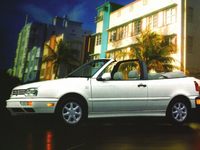New Car Review
SEE ALSO: Volkswagen Buyer's Guide
1996 VW GOLF CABRIO
By Matt/Bob Hagin
SPECIFICATIONS
Manufacturer's Suggested Retail Price $ 19,975
Price As Tested $ 24,320
Engine Type 2.0 Liter I4 w/SMPFI
Engine Size 121cid/1984 cc
Horsepower 115 @ 5400 RPM
Torque (lb-ft) 122 @ 3200 RPM
Wheelbase/Width/Length 97.4"/66.7"/160.6"
Transmission Four-speed automatic
Curb Weight 2764 Pounds
Fuel Capacity 14.5 gallons
Tires (F/R) P195/60HR14
Brakes (F/R) Disc (ABS)/drum (ABS)
Drive Train Front-engine/front-wheel-drive
Vehicle Type Five-passenger/two-door
Domestic Content N/A
Coefficient of Drag (Cd.) 0.37
PERFORMANCE
EPA Economy, miles per gallon
city/highway/average 22/28/24
0-60 MPH 10.4 seconds
1/4 Mile (E.T.) 17.8 seconds @ 79.4 mph
* Sequential multi port fuel injection
(There's been a convertible model in the Volkswagen catalog since it's very early days and when the Beetle drophead disappeared in '80, there was a Rabbit ragtop there to take it's place. Bob Hagin finds the latest VW Cabrio the answer to a stylish maiden' prayer while son Matt wishes it packet the VW V6 under the hood.)
MATT - Dad, if I had a wish-list to give the guys at Volkswagen it would be to make their V^ an option in the Cabrio. The car still uses only the 115 horse four-banger and the performance suffers by comparison to the Jetta GLK we had. When the company installs the V6 in this open car, it will have a lot more appeal to the general public.
BOB - The Volkswagen Cabrio isn't exactly that kind of a car, Matt. A convertible with a big V8 engine, rumbling pipes and fat tires appeals to the kind of driver who cruises around with a grim expression and wrap-around dark glasses. With the top down, the Cabrio kind of reminds me of a friendly wagging-tail, half-grown St. Bernard puppy. For a lot of owners, the car is as much a fashion statement as transportation.
MATT - It's the kind of an open air car that you can picture yourself in driving down a French highway going to Monte Carlo or The Alps on a balmy spring day. When I drove it, the road was more twisty and the weather was hot, but the car handled really well and at 115 horses the little two-liter engine puts out more than enough power. Unlike the other Golf-based cars in the VW line-up that are sold here, all Cabrios are made in Germany and they come out of the Karmann Coachworks plant in Ousenbruck. Karmann has been building the VW convertible for over 40 years and its custom coachwork touch is evident. The interior is really "tight" and well laid out. Our car came with cloth upholstery and the optional automatic transmission but leather upholstery is available
BOB - Being old, I would have preferred the standard stick-shift because it's more "sporting" but I dislike leather upholstery, especially in an open car. If the top is down and I wear shorts, the leather get so hot I can hardly sit on it. I liked the alloy wheels just for their looks and I recommend the optional air conditioning since it makes traffic almost bearable in summer.
MATT - I agree. Usually an a/c unit loses a lot of its cooling effectiveness in a convertible but the padded Cabrio top is made of six layers of heavy material and its as snug and as noiseless as the VW GTI sedan we had last month. I also like the fact that the rear window that's built into the top is glass and won't turn yellow and crack with age. The outer layer is so tough that the company has no qualms about having it put through an automatic car wash.
BOB - Well, I hope they put the top up when they do that. The top is definitely well fitted and the car actually looks more sleek with the top up than its GTI and Golf siblings. I can't say the same of the car when the top is down, however. I never could get used to the "bustle-back" look of the old Beetle Type 1 version with the top down and while this new Golf-based car isn't as outlandish as its ancestor, it still sticks up pretty high.
MATT - If the top were engineered to fit down any lower, it would probably intrude into the rear seat area or into the trunk. As it is, the rear seat area and the trunk space are as spacious as when the top is down as when it's up. The down side of the top is that it's not power-operated but its really a one-handed snap to lower and raise. The built-in roll-over bar that connects the two sides of the car is also a bit disconcerting at first, too, but it helps to keep the car rattle free, adds support for the rear window and would be very much appreciated by all the occupants if the car happened to go over.
BOB - Buy the way, Matt. How did you happen to come up with that reference to driving the VW Cabrio to Monte Carlo or through the French Alps?
MATT - I have to be honest and tell you that I've been watching your old '50's videos that were shot in Europe. I guess it rubbed off on me.



